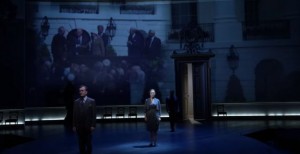To mark the Tony Award winning play Oslo opening in London this September, based on the Oslo Peace Process, Einat Wilf analyses its accuracy in terms of its portrayal of the actors involved and the negotiations that took place. Wilf argues that Oslo is a thinly disguised variation on the theme ‘The White Man’s Burden,’ in which the Israelis and Palestinians are wrongly represented as primitive tribes who require civilised, Western negotiators to end their conflict, as opposed to both peoples being sovereign agents who need to determine their future for themselves and by themselves.
The play Oslo which opens at the Lyttleton Theatre in London on 5 September, is ostensibly about peace. In reality, it is a thinly disguised variation on the theme of ‘The White Man’s Burden’. The play is not – as one might expect – about how Israelis and Palestinians came together in 1993 to forge an agreement intended to bring about peace over time. Rather, it is about how altruistic Norwegians were able to civilise, albeit only partially, two primitive warring tribes, that until the white man’s (and woman’s) saintly intervention, knew no better than to engage in senseless violence.
Multiple elements convey this message throughout the play: Israeli and Palestinian characters are portrayed as cartoonish stereotypes that emphasize their ‘otherness’; whatever issues underlie their conflict are mocked and dismissed; the violence between the sides is a decontextualised endless cycle with no reason; and the Norwegian diplomats – true to Norway’s historic standing as the world’s top exporter of Christian missionaries per capita – are on a mission from God. The bottom line, by the play’s end, is that ‘the white man and woman’ tried their best, but there is a limit to what one can do with brutes.
The crass stereotypes of Israeli and Palestinian characters were my first clue that something was deeply wrong with the play. When I recently saw Oslo in New York at the Lincoln Center Theater, being a member of one of the warring tribes, I was shocked by its portrayal of people with whom I worked closely and knew well… READ MORE



